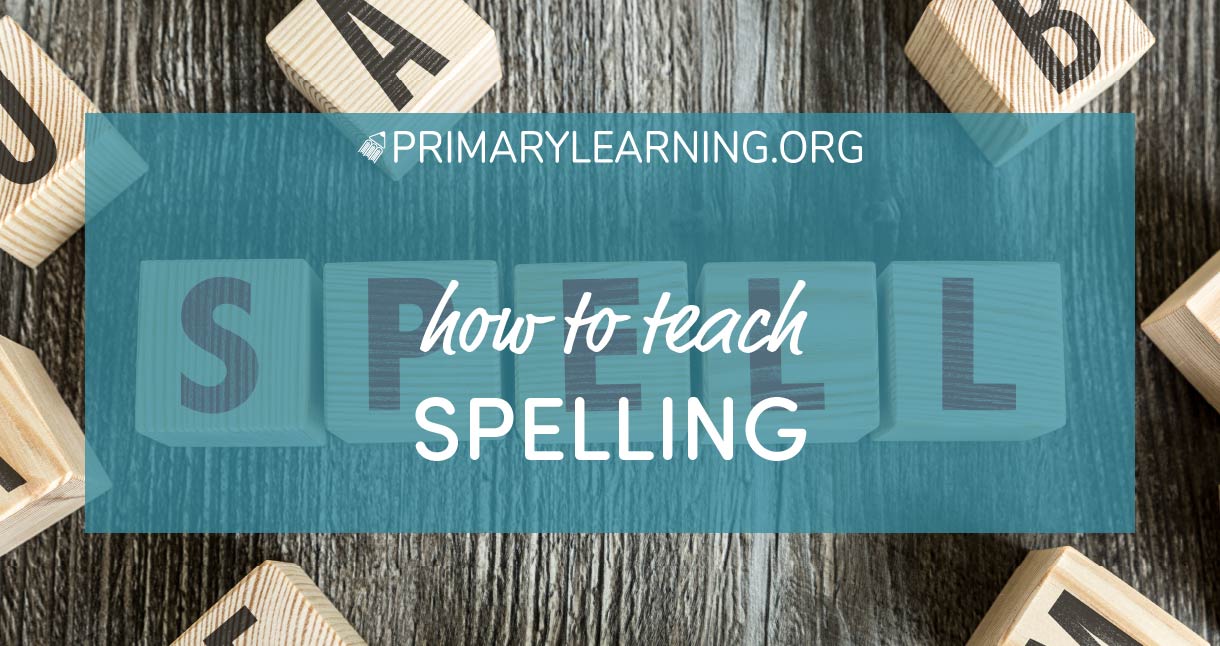

Posted by: Alesia Netuk
Updated: October 2nd, 2023
How To Teach Spelling
How To Teach Spelling
As young children explore literacy, they may begin writing letters and string a few letters together to look like words. As they progress in their learning, they begin recognizing the sounds letters make and, in particular, may use beginning sounds correctly to write words. Children start to correctly spell words of personal significance, such as their name, and common sight words with further experience and instruction. There are many strategies educators can use to support children as they increase the bank of words they can write independently.
The Link Between Reading and Writing
One of the most authentic ways to teach students how to spell is through the reading and writing connection. It allows them to learn how to spell words in context instead of learning them in isolation. For example, beginning readers may be learning new sight words, such as “the” and “it.”
Educators lead them in guided reading sessions using texts that contain these words. This is an ideal time also to have the students begin writing the words. Reading the words in print, paired with writing them, helps strengthen their memory of how the words look. Educators can take cues from their students to determine how frequently to introduce new words.
Roll, read, and trace activity is a great tool to link reading and writing:
AM Word Family Activities – Roll Read Trace
Practice reading and spelling AM family words in interactive and engaging way. AM word family words: swam, tram, jam, clam, yam, slam, ram.
EN Word Family Activities – Roll Read Trace
Practice reading and spelling EN family words in interactive and engaging way. EN word family words: wren, pigpen, men, ten, pen, Ben, glen.
IP Word Family Activities – Roll Read Trace
Practice reading and spelling IP family words in interactive and engaging way. IP word family words: chip, chip, hip, trip, lip, ship, flip.
OT Word Family Activities – Roll Read Trace
Practice reading and spelling OT family words in interactive and engaging way. OT word family words: cot, knot, dot, hot, lot, shot, tot.
Writing Activities
There are many ways students can practice learning to spell words. They may take a word and write it in a sentence. For beginning writers, they could write two or three sentences using a prescribed pattern.
For example, when learning the word “like,” students could use the sentence stem, “I like…” then complete the sentence with a picture or word. Having students create these patterned sentences in a book format allows them to read their book to others. This is another way to strengthen their recognition of the word “like.”
Students may enjoy spelling words using different modalities. They can write words using salt or sand trays. They can use paintbrushes and water to make words outside, on brick walls or pavement. They may enjoy using sidewalk chalk to create words. Markers and mini-whiteboards or chalk and mini-chalkboards are other ways to practice words. Students can also build words using magnetic letters or letter tiles.
Combine learning irregular words and sensory play with play dough mats:
Sight Word AND – Play Dough Mat
With this sight word AND play dough mat, kids learn how to read and spell the sight word AND in a hands-on and interactive way. Great for literacy centers.
Sight Word AND – Play Dough Mat
Sight Word EAT – Play Dough Mat
With this sight word EAT play dough mat, kids learn how to read and spell the sight word EAT in a hands-on and interactive way. Great for literacy centers.
Sight Word EAT – Play Dough Mat
Sight Word GROW – Play Dough Mat
With this sight word GROW play dough mat, kids learn how to read and spell the sight word GROW in a hands-on and interactive way. Great for literacy centers.
Sight Word GROW – Play Dough Mat
Sight Word MAKE – Play Dough Mat
With this sight word MAKE play dough mat, kids learn how to read and spell the sight word MAKE in a hands-on and interactive way. Great for literacy centers.
Sight Word MAKE – Play Dough Mat
Games
There are many games educators can introduce to students to practice spelling. Older students can play board games like Scrabble and Boggle for opportunities to make words. Students can also use specific word lists to create word searches and crossword puzzles for each other. For younger students who are beginning readers and writers, they may solve a word search that contains the same word multiple times. Hangman is another game that requires students to spell words correctly.
Recommended word search printables for spelling practice:
Kindergarten Word Search Spelling (Unit 7)
During week 7, kindergarten students practice the following words: am, we, hid, kid, lid.
1st Grade Word Search Spelling (Unit 7)
Use this 1st-grade word search to practice spelling words. Spelling words: went, are, now, no, bend, spend, lend, rest, test.
2nd Grade Word Search Spelling (Unit 7)
This worksheet is great for second graders to work on spelling words: how, know, put, towel, crown, town, howl, brow, down.
Kindergarten Word Search Spelling (Unit 33)
During week 33, kindergarten students practice the following words: find, must, day, say, hay.
Word Families
Educators may wish to introduce new spelling words by teaching students to word families. Word families are groups of words that share a common feature. For example, they may have the same ending. Students can learn an ending such as “ay,” then practice spelling words like “play,” “say,” and “day.” The next step may be to have students use their knowledge of “ay” words to create new words like “played,” “saying,” “days.”
The introduction of word families will be very dependent on students’ skill level and learning needs. Beginning writers may be able to learn word families such as “at” and “it.” Educators can model how to create “at” using magnetic letters. They can then add a letter, such as ‘c,’ to the beginning of the word ending to make the word “cat.” Once appropriately modeled, students can begin building words with the magnetic letters, learning how to switch the first letter to create new words, like “bat” and “sat.”
Students who are ready for more challenging words can learn word families such as “ight.” A word ending like this may require direct teaching, given the silent letters that students may be unfamiliar with. Students may also require explicit teaching to learn a word family such as “eat.” The challenging part is the different sounds “eat” make, depending on whether the letters are in a word like “great” or a word like “beat.”
Recommended printables for hands-on learning with spelling patterns:
AM Family Words | Chunk Detective
This worksheet helps young students read words by using chunks. Students break down AM family words. They apply these skills to read each word aloud.
AM Family Words | Chunk Detective
Building Words – AM Word Family Printables
With this worksheet, kids write eight words ending AM. Examples of AM word family words: tram, ram, jam, swam, yam, clam, slam.
Read and Spell AM Family Words
With this printable activity, kindergarteners learn to read and spell AM family words. Great addition to your literacy center and AM word family word work.
Read and Spell AM Family Words
AM Word Family Activity
Combining games with learning is a win-win situation. This AM word family activity is ready-to-use in your spelling station!
AM Word Family Activity
Spelling Rules
There are many rules students need to learn to spell words correctly. Additionally, there are exceptions to rules that students also need to learn. Educators may wish to use phrases like “i before e except after c” to help students remember the rule for spelling words like “receive” and “believe.” Then there are exceptions to learn, like “weight” and “height.”
Writers who have mastered consonant-vowel-consonant words, like “rat” and “bit,” may be ready to learn about long vowel sounds. Educators can introduce the silent ‘e’ and teach students how it changes vowel sounds from short to long. Students can practice changing “rat” to “rate” and “bit” to “bite.” Learning this rule opens up many more words students can add to their spelling repertoire.
Spelling Tricks
For words that students are having difficulty remembering how to spell, using a mnemonic may be helpful. They can use a mnemonic where each letter in a word stands for something. For example, to remember how to spell “because,” students can use the phrase, “Big Elephants Can Always Understand Small Elephants.” To remember how to spell “rhythm,” students can memorize the phrase, “Rhythm Helps Your Two Hips Move.” Students may enjoy creating their own phrases to help them remember how to spell words they find particularly challenging.
There are many ways to support students with spelling development. Educators can use a variety of activities and strategies, embedded into their language program and use cross-curricular connections, to help students learn how to spell words correctly.
LEARNING MATERIALS TO MEET EVERY CHILD’S NEEDS
Here, at PrimaryLearning.Org, we tend to deliver the best-differentiated learning materials to K-2 students. Our resources can be easily incorporated into multisensory lessons to meet every child’s needs, whether s/he is a visual, kinesthetic, or auditory learner.